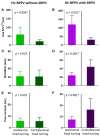Short-Term Central Adaptation in Benign Paroxysmal Positional Vertigo
- PMID: 32373046
- PMCID: PMC7186433
- DOI: 10.3389/fneur.2020.00260
Short-Term Central Adaptation in Benign Paroxysmal Positional Vertigo
Abstract
Objective: To elucidate the frequency, underlying mechanisms, and clinical implications of spontaneous reversal of positional nystagmus (SRPN) in benign paroxysmal positional vertigo (BPPV). Methods: We prospectively recruited 182 patients with posterior canal (PC, n = 119) and horizontal canal (HC) BPPV (n = 63) canalolithiasis. We analyzed the maximal slow phase velocity (maxSPV), duration, and time constant (Tc) of positional nystagmus, and compared the measures between groups with and without SRPN. We also compared the treatment outcome between two groups. Results: The frequency of SRPN in PC- and HC-BPPV was 47 and 68%, respectively. The maxSPVs were greater in BPPV with SRPN than without, larger in HC-BPPV than PC-BPPV (114.3 ± 56.8 vs. 57.1 ± 38.1°/s, p < 0.001). The reversed nystagmus last longer in HC-BPPV than PC-BPPV. The Tc of positional nystagmus got shorter in PC-BPPV with SRPN (3.7 ± 1.8 s) than without SRPN (4.5 ± 2.0 s, p = 0.034), while it was longer during contralesional head turning in HC-BPPV with SRPN (14.8 ± 7.5 s) than that of ipsilesional side (7.3 ±2.8 s, p < 0.001). The treatment response did not significantly differ between groups with and without SRPN in both PC- and HC-BPPV (p = 0.378 and p = 0.737, respectively). Conclusion: The SRPN is common in both PC- and HC-BPPV canalolithiasis. The intensity of rotational stimuli may be a major determinant for the development of short-term central adaptation which utilizes the velocity-storage system below a certain velocity limit. The presence of SRPN is not related to treatment outcome in BPPV.
Keywords: adaptation; benign paroxysmal positional vertigo; nystagmus; spontaneous reversal; velocity storage system.
Copyright © 2020 Choi, Lee, Oh, Choi and Choi.
Figures




Similar articles
-
Head-Shaking Nystagmus in Posterior Canal Benign Paroxysmal Positional Vertigo with Canalolithiasis.J Clin Med. 2021 Feb 26;10(5):916. doi: 10.3390/jcm10050916. J Clin Med. 2021. PMID: 33652740 Free PMC article.
-
[Benign paroxysmal positional vertigo of the horizontal canal. Clinical features in 25 patients].Ann Otolaryngol Chir Cervicofac. 2002 Apr;119(2):73-80. Ann Otolaryngol Chir Cervicofac. 2002. PMID: 12015491 French.
-
Clinical Characteristics of Patients With Benign Paroxysmal Positional Vertigo Diagnosed Based on the Diagnostic Criteria of the Bárány Society.Front Neurol. 2020 Jul 3;11:602. doi: 10.3389/fneur.2020.00602. eCollection 2020. Front Neurol. 2020. PMID: 32719648 Free PMC article.
-
Classification, diagnostic criteria and management of benign paroxysmal positional vertigo.Auris Nasus Larynx. 2017 Feb;44(1):1-6. doi: 10.1016/j.anl.2016.03.013. Epub 2016 May 9. Auris Nasus Larynx. 2017. PMID: 27174206 Review.
-
[HORIZONTAL CANAL - BENIGN PAROXYSMAL POSITIONAL VERTIGO (HC-BPPV) - CLINICAL DIAGNOSTIC PROCEDURES].Harefuah. 2017 Mar;156(3):176-180. Harefuah. 2017. PMID: 28551938 Review. Hebrew.
Cited by
-
Concomitant long-arm cupulolithiasis and short-arm canalithiasis involving the posterior canal.J Neurol. 2025 Jan 15;272(2):117. doi: 10.1007/s00415-024-12881-5. J Neurol. 2025. PMID: 39812701 No abstract available.
-
Nystagmus Parameters of Supine Roll Test Correlates With Prognosis After Repositioning Maneuver in Horizontal Semicircular Canal Benign Paroxysmal Positional Vertigo.Front Neurol. 2021 Dec 6;12:790430. doi: 10.3389/fneur.2021.790430. eCollection 2021. Front Neurol. 2021. PMID: 34938267 Free PMC article.
-
Characteristics and Possible Mechanisms of Direction-Reversing Nystagmus During Positional Testing in Patients With Benign Paroxysmal Positional Vertigo.Otol Neurotol. 2023 Aug 1;44(7):e512-e518. doi: 10.1097/MAO.0000000000003928. Epub 2023 Jun 29. Otol Neurotol. 2023. PMID: 37400137 Free PMC article.
-
Canal switch in benign paroxysmal positional vertigo: Clinical characteristics and possible mechanisms.Front Neurol. 2022 Nov 14;13:1049828. doi: 10.3389/fneur.2022.1049828. eCollection 2022. Front Neurol. 2022. PMID: 36452167 Free PMC article.
-
Upbeat and Direction-Changing Torsional Nystagmus While Straight Head Hanging: A New Sign of Benign Paroxysmal Positional Vertigo Involving Bilateral Posterior Semicircular Canals.J Clin Neurol. 2024 Jan;20(1):100-102. doi: 10.3988/jcn.2023.0299. J Clin Neurol. 2024. PMID: 38179639 Free PMC article. No abstract available.
References
-
- Mcclure JA. Horizontal canal Bpv. J Otolaryngol. (1985) 14:30–5. - PubMed
LinkOut - more resources
Full Text Sources

